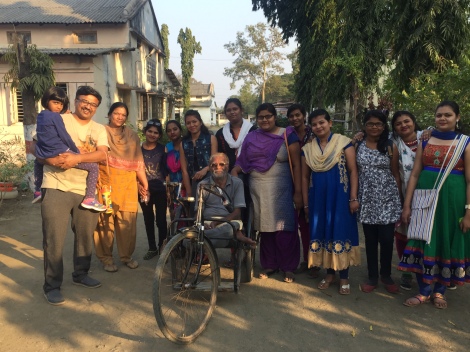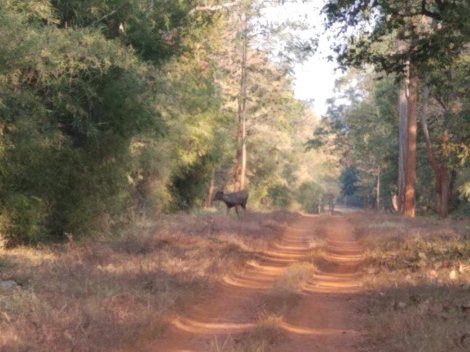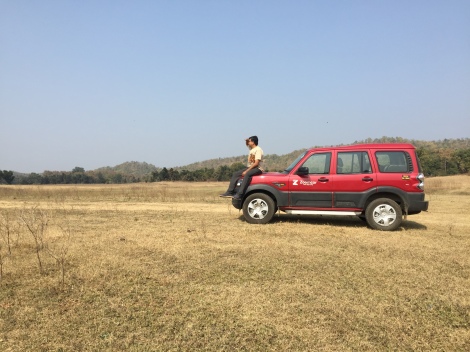Ever been to a vacation kicking and screaming and had the time of your life? I am not a fan of winters, unless there is a beach around and I am lounging with a margarita in my hand. Last year, Gaurav decided to forgo our usual pilgrimage to a beach destination and planned a visit to Nagpur and Tadoba, which is apparently a wild life sanctuary famous for most tiger sightings in India. I had never heard of it before. I was like – you want me to travel in foggy, chilly weather to Delhi and then fly over to Nagpur, drive to Tadoba to see tigers when we were not able to find this elusive animal in Jim Corbett, the land of Tigers? He cajoled and pushed me to not only make this trip, but to take an overnight Volvo bus to Delhi, since our flight was at an ungodly hour at 7:00 in morning from the capital. Suffice to say, I had to eat all my words with extra seasoning. It was a fantastic trip. Not only did we trail a tiger but got to see wildlife up close and personal and had a very humbling trip to ‘Anandvan’ established by Baba Amte.
Reaching Delhi bleary eyed and gorging on Krispy kreme doughnuts at the airport, we boarded our early morning flight to Nagpur.

Since I was all jacked up on coffee, I was wide awake with most of the passengers nodding off. Saw a very interesting phenomenon. On the right side of the plane while, it was pitch black with a shiny moon. On the left side, I saw a beautiful sunrise with Sun at the horizon. I was itching to capture it on my camera, but got dirty looks form passengers when I tried using my flash. Even got disgruntled words from my daughter when I nudged her excitedly. Well, their loss.
Nagpur airport is small but beautiful. We rented a self driven Scorpio car and zoomed away to Tadoba, which is around 2 ½ hour from Nagpur. We were all on the lookout for oranges. Am sure you can guess why. Yup, Nagpur being land of oranges, we were eagerly waiting for a cart with the juicy fruit. But apparently, it was not a season (we went in January) for oranges in Nagpur. While in North India, oranges are seen in winters, but in Nagpur not so much. The drive to Tadoba was very interesting and for the first time, I saw cotton plantation. The scenery was a mix of small plateaus, barren land, cotton plantation and small villages.
We reached our destination just in time to go for the afternoon safari in the forest area. Tadoba jungle santury has 12 gates.
We could not get ticket for core jungle gate – Moharli, which apparently holds record of multiple tiger sightings. But, no worries, our guide zoomed away the safari jeep right where Tigress Sharmili was roaring loudly. Annnd he stopped the jeep.
I was all set with my camera ready to click. The roaring got louder and angrier. Though we are not supposed to, I whispered to the guide – why is she roaring? Is it normal? He replies – No, no. Sharmili is just angry. She lost her 3 cubs in the morning and is looking for them. Apparently the young cubs (4 months) old were eating a deer killed by their mom and after their tummies were full, they merrily followed their dad and were lost now. And we all know how responsible dads are. Excitement on hold, I got a teensy bit apprehensive about the chances of us being the next meal of an angry tigress. But fortunately, like all good mom’s. Sharmili was focused on getting her kids back. Reassured, we again sat waiting with our cameras ready to shoot. Aaaand then it happened. An angry roaring tigress stalking out, is truly a sight to behold.
I was spellbound. She came out on the dirt track and we followed her for 20 minutes at a close range of about 200 meters. We have all seen plenty of tigers in various zoos, but let me tell you, seeing this majestic animal prowling around in her jungle is a totally different experience.
 The tigress was calling out for her cubs and we could hear scared deer barking to warn the other animals. Now, I got why wild life photographers sit for hours waiting for a sighting.
The tigress was calling out for her cubs and we could hear scared deer barking to warn the other animals. Now, I got why wild life photographers sit for hours waiting for a sighting.
 While we were trailing behind Sharmili, some wild dogs had attacked a herd of deer and had killed one. We got to see the half eaten fresh kill. Crocodiles slumbering during afternoon siesta, huge Sambars, wild dogs encircling and attacking a deer, Bisons, Indian gaur, deer herds were some of the animals we saw. In the four hour safari, I got the feel that I was in the middle of an episode of National Geographic. The guides are very knowledgeable and showed us not only the animals, but described the foliage and the nature of animals as well.
While we were trailing behind Sharmili, some wild dogs had attacked a herd of deer and had killed one. We got to see the half eaten fresh kill. Crocodiles slumbering during afternoon siesta, huge Sambars, wild dogs encircling and attacking a deer, Bisons, Indian gaur, deer herds were some of the animals we saw. In the four hour safari, I got the feel that I was in the middle of an episode of National Geographic. The guides are very knowledgeable and showed us not only the animals, but described the foliage and the nature of animals as well.
Tadoba is unique, since it has lots of bamboo trees in addition to the jungle foliage. Bamboo trees are not part of the natural flora, but were planted by the govt., to make forests dense and to balance the eco-system. It was fascinating to see tiger nail marks marking their territory. Another interesting fact, apparently Tigers are shy and it’s mostly Tigresses that come out and enthrall the tourists.
I have visited other wildlife sanctuaries in past– Jim Corbett, kabini – both in India. One interesting difference I noticed that animals in Tadoba are not afraid of humans and are neither aggressive as long as one maintains a respectful distance. While in Jim Corbett, a simple heard of deer would run away on seeing a jeep of tourists or even an unusual sound. But in Tadoba, we saw wild animals up close and personal. Interestingly, every morning deer with their fawn and various birds would come to eat grass and drink water from a lake behind our stay. They would walk a mere 15 feet close to us, stay for a couple of hours aware of our presence. It was a beautiful cohabitation of humans and wild animals.
The reason for the vast difference in the animals behavior, I concluded was due to minimal poaching in Tadoba. Otherwise, how can one explain 117 tigers (maximum number) in Tadoba, animals not scared of humans, 90% tourists have tiger sightings and villagers claiming hardly any loss of life or farm animals to the mighty tiger? One can feel the pride of guides and even the curio shop keepers outside the jungle boast about their jungle and its inhabitants. It was so much fun exchanging stories of tiger sightings with other guests at our stay. Almost everyone who had seen one or more tigers or tigresses, and even the repeat visitors, held an expression of awe. I excitedly went back and started regaling other wild life enthusiasts with my sightings of Sharmili. Guess what? They had not only met Sharmili, but madhuri (with a notched ear), katrina as well. Yup!! The locals have named their tigresses after the leading bollywood ladies.
After another day at Tadoba, we drove back towards Nagpur, next destination being Pench Sanctuary. On the way, we halted at Anandvan – a venture or township or abode (don’t know what to call it) established by Baba Amte in 1967 and now run by his elder son Dr Vikas. Baba Amte, fought not only the Indian Govt but the general public as well and founded Anadvan as a place for leprosy patients to live, be treated and rehabilitate. He and his wife were shunned by the society and his own family since he would pick up the leprosy patients from road, bring them home and treat them. He had no help at all, but along with his wife and few friends built Anadvan one hut at a time. Now, this township is spread over 1200 acres. It has multiple industries – shoe making, bag making, rug making, sweater, paintings, hydroelectric plant, plastic recycling plant to name a few.
The patients of leprosy and with other handicaps (blind, paralyses etc) along with their family are given homes and jobs here. They have schools, colleges, hospitals and boast one of the most famous Agriculture University in India where admission is free. The atmosphere there is very peaceful. When we entered, few things struck me – people were very calm, not hurrying around, had a smile on their face (blinds, wheel chair bound all included), worked in a systematic manner and were happy. Oh! Most importantly, I didn’t see any walking cell phones. We went to the main office for a tour of Anadvan and were shown a short film about the history of the place. It was in Marathi (state language), but lucky for me, Gaurav had studied in Maharashtra for 8 years and knew most of it. Fortunately, the weather was very pleasant and we set out on a tour accompanied by our guide, a 66 year old man with wasted legs on a wheelchair. He had a personality to not only see but also to feel; very proud to be part of Anadvan, smile on his face, running his wheelchair all round and making fun of us and bossing us around.

tour guide with group
You know what message I took from Anandvan – Dignity of work. We visited and talked to people working in different manufacturing plants. Initially they were shy, but then later on loved to interact with visitors specially kids. My daughter was totally fascinated with the artisans, doing beautiful carvings with just finger stumps (recovered leprosy patient). They even had a small zoo with Emu birds in it. Interestingly, Baba Amte was totally ignored once he got the land to establish the Anandvan, but the moment he was recognized outside India for his selfless efforts, suddenly the Indian politicians wanted to be clicked along with him. He got many awards and more aid, which helped him to expand his efforts wider.
After paying homage at Baba and his wife’s shrine, we set on wards towards our next destination – Pench jungle.
Here the stay was more relaxing with open areas to swing on tires and chill along the night bonfires.
We did go for a safari in Pench as well. The jungle was different than Tadoba. It was hilly, while Tadoba is more of grassland. The trees here were Sal and Teek. We did see a lot of wild life including wild boars, but no tiger.

sambhar at pench
Night before flying back, we went for a night stroll in the jungles around. Light lamps fixed to our head, we were aiming at seeing the night wild life, but considering the amount of noise my kiddo was making, there was a fat chance of that happening. But, we ended up disturbing birds called jumphri (local name) from their sleep. Interestingly, these birds were not sleeping on trees, but on ground.
Last but not the least – food. Oh my God! The food. Maharashtrian food is amazing. We loved eating local cuisine and once the cook came to know of our interest, he prepared such lovely dishes.
The taste is exquisite, with only one requirement. Carry a cast Iron stomach or some antacids cos Maharashtrian food is really really spicy. Zunka Bhakri, Pav bhaji, missal pav, vada pav were some of the snacks that we feasted on while on way to Pench. Rautwadi, Bharli vangi (stuffed eggplant), Zunka bhakri, tomato chutney were some of the main dishes that we sampled as main dishes.
All in all the stay was fantastic. Since, both me and Gaurav love to self drive, taking a zoomcar on rent was very convenient.

renting zoom car – best decision
The pick-up and drop of the car was from the airport, so no added hassle. I would strongly recommend for the wild life lovers to visit Tadoba, but make online reservation for the core jungle gate i.e. Moharli well in advance.
A few interesting clicks my my little budding photographer – Chandana has been dipping her toes into photography



































Great write up…. very well narrated
thank you bua
Wonderful review .. we would definitely love to visit . … the trip was outlined so well that it can be copied just the same way . Looking at your little girl enjoying , gives me an idea how my kids would like it . Kudos to your exploration.. hope to see more of your travel blogs .. loved the description. All the best
Thank you
Very nicely described.. loved the details.. safari, animals, local food, sightseeing.. really good.. will definitely plan to visit with kids.. wonderful blog.. keep writing.. will look forward for another one..
thanks
Thoroughly enjoyed the virtual tour described so well by you. What fun to explore this part of our diverse habitat in this involving manner.
thanks dear